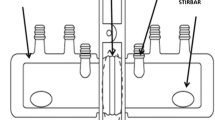Abstract
Intestinal absorption of many hydrophilic drugs cannot be explained solely in terms of pH-partition and solvent-drag effects have been described in a number of cases. However, quantitative estimates of sieving coefficient (Φ) for drug molecules have tended to be variable. In the present work anin situ perfused intestinal loop preparation in the rat has been used to measure the disappearance of five hydrophilic drugs from the intestinal lumen and a mathematical model of drug absorption in the presence of net and unidirectional fluid fluxes has been developed. The model allows separate estimation of the convective (solvent drag) and nonconvective (partition) components of drug absorption from the experimental data. The five drugs studied were found to have Φ values ranging from 0.1–0.9; this was highly dependent on molecular size. Analysis of the data shows that three of the drugs are absorbed almost exclusively by the convective process (caffeine, cimetidine, hydrochlorthiazide) while the other two are absorbed by both convective and nonconvective processes (salicylate, oxprenolol). We conclude that the methodology is a useful and reliable means of deriving separate estimates of these two components of drug absorption.
Similar content being viewed by others
References
P. A. Shore, B. B. Brodie, and C. A. M. Hogben. The gastric secretion of drugs: a pH-partition hypothesis.J. Pharmacol. Exp. Ther. 119:361–369 (1957).
L. S. Schanker, D. J. Tocco, B. B. Brodie, and C. A. M. Hogben. Absorption of drugs from the rat small intestine.J. Pharmacol. Exp. Ther. 123:81–88 (1958).
N. Lifson and A. A. Hakim. Simple diffusive-convective model for intestinal absorption of a non-electrolyte (urea).Am. J. Physiol. 211:1137–1146 (1966).
G. Barnett, S. Hui, and L. Z. Benet. Effects of theophylline on salicylate transport in isolated rat jejunum.Biochem. Biophys. Acta 507:517–523 (1978).
H. Ochsenfahrt and D. Winne. The contribution of solvent drag to the intestinal absorption of tritiated water and urea from the jejunum of rat.Naunyn-Schmiedebergs Arch. Pharmacol. 279:133–152 (1973).
W. Ochsenfahrt and D. Winne. The contribution of solvent drag to the intestinal absorption of the basic drugs amidopyrine and antipyrine from the jejunum of rat.Naunyn-Schmiedebergs Arch. Pharmacol. 281:175–196 (1974).
H. Ochsenfahrt and D. Winne. The contribution of solvent drag to the intestinal absorption of the acidic drugs benzoic acid and salicylic acid from the jejunum of rat.Naunyn-Schmiedebergs Arch. Pharmacol. 281:197–217 (1974).
A. Karino, M. Hayashi, T. Horie, S. Awazu, H. Minami, and M. Hanano. Solvent drag effect in drug intestinal absorption. I Studies on drug and D2O absorption clearances.J. Pharmacobiodyn. 5:410–417 (1982).
A. Karino, M. Hayashi, S. Awazu, and M. Hanano. Solvent drag effect in drug intestinal absorption. II Studies on drug absorption clearance and water influx.J. Pharmacobiodyn. 5:670–677 (1982).
Y. Miyamoto, H. Yuasa, T. Iga, and M. Hanano. Determination of the membrane permeability and the reflection coefficient by the two-dimensional laminar flow model for intestinal perfusion experiments.Biochim. Biophys. Acta 854:191–197 (1986).
K. Diem and C. Leutner (eds.).Documenta Geigy Scientific Tables VIIth Edition, Ciba Geigy, Basle, Switzerland, 1970, pp. 280–282.
O. Kedem and A. Katchalsky. Thermodynamic analysis of the permeability of biological membranes to non-electrolytes.Biochim. Biophys. Acta 27:229–246 (1958).
O. Kedem and A. Katchalsky. A physiological interpretation of the phenomenological coefficients of membrane permeability.J. Gen. Physiol. 45:143–179 (1961).
K. H. Ryu and E. Grim. Unstirred water layers in canine jejunum.Am. J. Physiol. 242:G364-G369 (1982).
S. G. Shultz. Intestinal absorption of Na and Cl. In M. Field, J. S. Fordtran, and S. G. Shultz (eds.),Secretory Diarrhea, American Physiological Society, Bethesda, MD., 1989, pp. 1–9.
H. Yuasa, Y. Miyamoto, T. Iga, and M. Hanano. Intestinal Absorption by carriermediated transports: Two-dimensional laminar flow model.J. Theoret. Biol. 119:25–36 (1986).
D. W. Powell, L. I. Solberg, G. R. Plotkin, D. H. Catlin, R. M. Maeuza, and S. B. Formal. Experimental diarrhoea: III. Bicarbonate transport in rat salmonella enterocolitis.Gastroenterology 60:1076–1086 (1971).
D. S. Parsons. The absorption of bicarbonate saline solutions by the small intestine and colon of the white rat.Quart. J. Exp. Physiol. 41:410–420 (1956).
J. T. Dolusio, N. F. Billups, L. W. Ditternt, E. T. Sugita, and J. V. Swintosky. Drug absorption I: Anin situ rat gut technique yielding realistic absorption rates.J. Pharm. Sci. 58:1196–1202 (1969).
R. A. Frizzell, M. Field, and S. G. Schultz. Sodium-coupled chloride transport by epithelial tissues.Am. J. Physiol. 5:F1-F8 (1979).
D.-A. Hallback, M. Jodal, A. Sjoqvist, and D. Lundgren. Evidence for cholera secretion emanating from the crypts.Gastroenterology 83:1051–1056 (1982).
B. E. Cohen. The permeability of liposomes to non-electrolytes. I. Activation energies for permeation.J. Membrane Biol. 20:235–268 (1975).
H. J. Worman and M. Field. Osmotic water permeability of small intestinal brushborder membranes.J. Membrane Biol. 87:233–239 (1985).
E. M. Renkin and F. E. Curry. In G. Giebisch, D. C. Tosteson, and H. M. Ussing (eds.),Membrane Transport in Biology, Vol 4A, Springer, Berlin, 1979, pp. 1–46.
D. E. Leahy. Intrinsic molecular volume as a measure of the cavity term in linear solvation energy relationships: Octanol-water partition coefficients and aqueous solubilities.J. Pharm. Sci. 75:629–636 (1986).
SAS, Statistical Analysis System, SAS Institute Inc., Box 8000 Carey, NC 27511, 1974.
Author information
Authors and Affiliations
Rights and permissions
About this article
Cite this article
Leahy, D.E., Lynch, J., Finney, R.E. et al. Estimation of sieving coefficients of convective absorption of drugs in perfused rat jejunum. Journal of Pharmacokinetics and Biopharmaceutics 22, 411–429 (1994). https://doi.org/10.1007/BF02353863
Received:
Accepted:
Published:
Issue Date:
DOI: https://doi.org/10.1007/BF02353863




